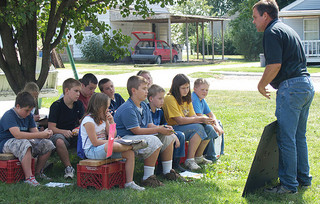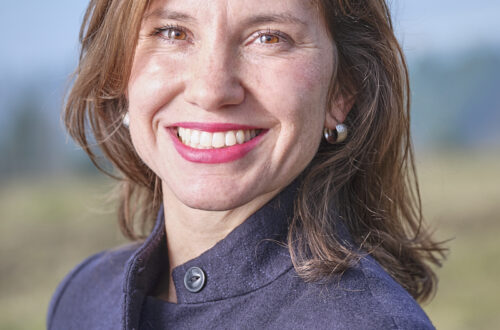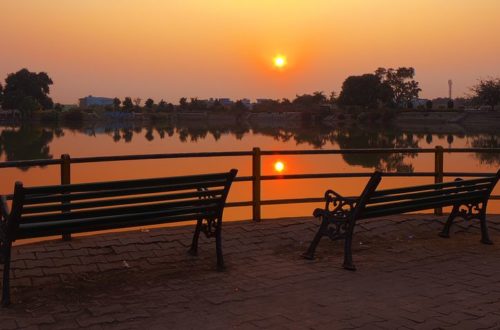Something’s Happening Here
As you stroll down the halls of your neighborhood school at nine o’clock on a Wednesday morning, you notice that something is different. Many of the classrooms are empty; the students are not in their places with bright, shiny faces. Where are they? In the town woodlot, a forester teaches tenth graders to determine which trees should be marked for an upcoming thinning project. Downtown, a group of middle school students are collecting water samples in an urban stream to determine if there’s enough dissolved oxygen to support reintroduced trout. Out through the windows, you can see children sitting on benches writing poems.
Down the way, a group of students works with a landscape architect and the math teacher to create a map that will be used to plan the schoolyard garden. Here’s a classroom with students. In it, eighth graders are working with second graders to teach them about the history of the local Cambodian community. In the cafeteria, the city solid-waste manager is consulting with a group of fifth graders and the school lunch staff to help them design the recycling and composting program. Students’ bright shiny faces are in diverse places in their schoolyards and communities.
You don’t have to pinch yourself. It’s not a dream. Place-based education is taking root in urban and rural, northern and southern, well-to-do and rough-around-the-edges schools and communities across the country. Take a whirlwind tour with me as we drop in on some of these happenings.
Two recent headlines in the Littleton, New Hampshire, Courier paint the picture: “Using the River as a Textbook” and “The Town Becomes the Classroom.” Like many small New England cities, Littleton turned its back on its downtown river, the Ammonusuc, at the end of the nineteenth century. Now, with funding from the Department of Transportation, the town is creating a Riverwalk, which will connect Main Street with the river and open up a new economic development zone. Working in conjunction with the town planner and the town engineer, teachers and community members are engaging students in the design of a river museum at one end of the Riverwalk. Different grades will become responsible for the changing exhibitry of the museum. High school history students might create exhibits on logging history in the Great Northern Forest. Sixth-grade science students will design hands-on water testing activities. Perhaps third graders will take on the task of creating the entrance mural as part of their study of local plants and animals.
The town is already functioning as a classroom in a novel collaboration between Chutter’s General Store and the marketing program at the Littleton High School’s vocational center. When the well-established downtown candy store realized that its internet sales site was costing more than the revenues it generated, the owners looked to the school for a solution. The high school needed more space and the marketing class was seeking real-world projects. The school district and the town agreed to rehabilitate a space below the candy store to create a marketing classroom for less than it would cost to build new space at the high school. By having the marketing class take over Chutter’s internet business, the students get economics experience and the candy store owners generate a bit of revenue as a result of the reduced labor costs. Through a balanced focus on economic development and environmental preservation, the community gets revitalized and the state curriculum standards are met.
In Louisiana, getting out of the classroom often means getting into mosquitoes, so the 4H Club at Caldwell Middle School in Terrebonne Parish took on the real-world challenge of mosquito control. One parent, whose daughter has asthma, was interested in finding ways to control mosquitoes in residential areas without aerial spraying of pesticides. First, students and teachers started to experiment with raising guppies to see if they would eat mosquito larvae. But these students got a lesson in ecology when a professor from Nichols State University recommended native mosquito fish instead, because of the problems caused when nonnative species are introduced into local waters. Students bred the mosquito fish and then released them into stagnant ponds, ditches, and even swimming pools. Just a fun project? Melynda Rodrigue, 4H sponsor and Caldwell teacher, indicated that math teachers will chart the numbers of offspring and the time period needed to repopulate the tanks, science classes will study the fish’s life cycle, and social studies classes will study the impact on the community’s environment. Some students used their writing skills to create a brochure for distribution to the community, and other students got public speaking experience through presentations at other schools in the area.
In Berkeley, California, a similar grassroots school-and-community effort has been transformed into a bioregional initiative. From one vegetable garden at the Martin Luther King Middle School came the idea to have a garden on every schoolyard in Berkeley, which spread to the idea of a garden on every schoolyard in California. And since you can’t realistically feed all the children in any one school with produce from one garden, why not create connections between local farmers and the school district? Instead of freeze-dried burritos trucked in from the Midwest, how about burritos with organic beans and cheese grown and produced by area farmers who are threatened by suburban sprawl? These ideas have led to the creation of the Food Systems Project, where the aim is to have all the food in the Berkeley school lunch program be organic and locally grown within the next decade. At the same time, food preparation and agriculture education become an integral part of each school’s curriculum.
The Food Systems Project is funded by the United States Department of Agriculture’s Linking Farms to Schools initiative, the California Department of Health, and the Center for Ecoliteracy, a broad coalition of funders trying to address the problems of child nutrition, school improvement, and sustainable agriculture in an integrated fashion. Project director Janet Brown comments “By using food as an organizing principle for systemic change, the program addresses the root causes of poor academic performance, psychosocial behavior disorders, and escalating children’s health issues such as obesity, asthma and diabetes. At the same time the program connects the loss of farmland and farming as a way of life and the social problems facing school communities (Sobel, Orion Afield, 2001).
Doesn’t it make sense–using the daily meal as a focal point for learning? Comenius, the seventeenth-century education philosopher, articulated one of the core precepts of place-based education when he said, “Knowledge of the nearest things should be acquired first, then that of those farther and farther off.” (Woodhouse, Thresholds, 2001) You can’t really get much nearer than the internal micro-environment of your digestive system as a focal point for the curriculum. The mosquito-breeding ponds in your backyard and the down town places where you shop are similarly appropriate contexts for learning. And so, as the rallying cry for place-based educators, I nominate that popular Beatles refrain, “Get back. Get back. Get back to where you once belonged.”
Distance from Beauty
If we’re going to get back, we need to look first at where we are now. Katie Avery, third grade teacher in the White Mountain-encircled town of Gorham, New Hampshire, got at the crux of the problem during a curriculum planning meeting when she asked, “Why are we using textbooks that focus on landforms in Arizona when we have such amazing resources right in our backyard?” Good question. Here’s the picture: Gorham sits in the shadow of Mount Washington, the loftiest peak in New England, and home to the worst weather in the world. The Presidential Range has a fascinating alpine zone, classic glacial cirques, and some of the most awe-inspiring mountain terrain in the country. Yet most of the students have never hiked the mountains and the curriculum ignores the great local teaching resources. Instead, geography is taught using pretty pictures of faraway places.
Generic textbooks designed for the big markets of California and Texas provide the same homogenized, unnutritious diet as all those fast-food places on the strip. The landscape of schooling looks like sprawl America. State-mandated curriculum and high-stakes tests put everyone on the same page on the same day and discourage an attention to significant nearby learning opportunities. Educational biodiversity falls prey to the bulldozers of standardization. Schools hover like alien spacecraft, luring children away from their home communities. More and more, we drive a wedge between our children and the tangible beauty of the real world.
In the provocatively titled article ”How My Schooling Taught Me Contempt for the Earth,” Bill Bigelow illustrates this alienation. During his boyhood in the late 1950s, he rambled the hills around his home in Tiburon, California, just across the bridge from San Francisco. “I loved the land. I spent every after-school moment and every weekend or summer day, outside until it got dark. I knew where to dig the best underground forts and how to avoid the toffee-like clay soil … I knew from long observation at nearby ponds the exact process of a pollywog’s transition into a frog, and the relative speed of different kinds of snakes: garter vs. gopher vs. western racer… (We also) had a love/hate relationship with ‘development.’ Almost as another natural habitat, we played in the houses under construction: hide and seek, climbing and jumping off roofs, and rafting in basements when they flooded.”
Located near wetlands, grasslands, remnant redwood forests, and new development, the school was well situated for field trips and for social and natural science learning.
How did our schooling extend or suppress our native earth-knowledge and our love of place? Through silence about the earth and the native people of Tiburon, Bel-Aire School, perched on the slopes of a steep golden-grassed hill, taught plenty. We actively learned to not-think about the earth, about that place where we were. We could have been anywhere–or nowhere. Teachers made no effort to incorporate our vast, if immature, knowledge of the land into the curriculum. Whether it was in the study of history, writing, science, arithmetic, reading or art, school erected a Berlin Wall between academics and the rest of our lives. The hills above the school were a virtual wilderness of grasslands and trees, but in six years, I can’t recall a single ‘field trip’ to the wide-open spaces right on our doorstep. We became inured to spending days in manufactured space, accustomed to watching more earth bulldozed and covered with yet more manufactured spaces. (Bigelow, 1996)
It was the same everywhere. In my mid-twenties, I got interested in plant taxonomy. After peering at a violet under a hand lens one afternoon, I paged through Gray’s Manual of Botany trying to understand the difference between stamens, pistils and calyxes, when poof! the proverbial light bulb went on. In my mind’s eye, I saw the much-larger–than-life-size model of a flower that had perched on the lab table at the front left corner of my tenth grade biology classroom. “That was a model of flowers that grew right outside the classroom door!” I said to myself in disbelief. As a high school biology student, my unquestioned misconception was that this was a model of a rainforest flower, or at least a far-away flower. It never occurred to me that real flowers, with real flower parts, existed on the school playground. Yet, I was your true science geek–carried a slide rule, got over 700 on my biology achievement test, and planned on following Martin Arrowsmith’s footsteps into biochemical research. I was on the ball, but most of our teachers had no sense that it was important to connect up the classroom world with the nearby outside world.
Place-based education is the antidote to the not-thinking about the Earth common in many schools. Instead of settling for textbook accounts of distant places, Katie Avery and the other third graders at Edward Fenn Elementary School worked with a children’s book author to write and illustrate a book about Gorham. As you read it, you “laugh at the hilarious adventures of Peewee Skunk, Amos Moose and Shylee Beaver, go back in time and learn about the history of Gorham, visit different places around Gorham today, and find out about the jobs people do.” Is it a surprise that the third grade social studies test scores and civic pride increased as a result of this project? Which leads us into a definition for place-based education:
Place-based education is the process of using the local community and environment as a starting point to teach concepts in language arts, mathematics, social studies, science and other subjects across the curriculum. Emphasizing hands-on, real-world learning experiences, this approach to education increases academic achievement, helps students develop stronger ties to their community, enhances students’ appreciation for the natural world, and creates a heightened commitment to serving as active, contributing citizens. Community vitality and environmental quality are improved through the active engagement of local citizens, community organizations, and environmental resources in the life of the school.
Place-based education converts the activist plaint of Not in My Backyard (NIMBY) to Please in my Backyard (PIMBY). As a truly grassroots movement, its practitioners draw strength from the image of those hearty dandelions and other herbaceous plants that force their way up through asphalt. As William James described, “I am done with great things and big things, great institutions and big success, and I am for those tiny, invisible, molecular moral forces that work from individual to individual by creeping through the crannies of the world like so many rootlets, or like capillary oozing of water, yet which, if you give them time, will rend the hardest monuments of man’s pride.”
Drops of waters and rootlets unite! Give me your students yearning to be free! It’s a simple proposition really. Bring education back into the neighborhood. Connect students with adult mentors, conservation commissions, and local businesses. Get teachers and students into the community, into the woods and on the streets–closer to beauty and true grit. Get the town engineer, the mayor, and the environmental educators onto the schoolyard and inside the four walls of the school. This is where we belong.
David Sobel is a faculty member at Antioch University NE and author of Place-Based Education Connecting Classrooms & Communities published by The Orion Society





